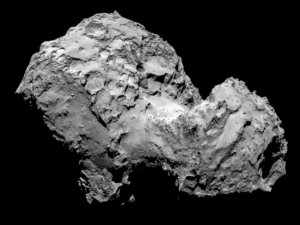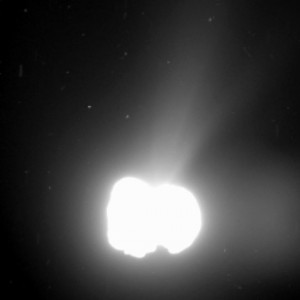
 On August 6, after a decade-long journey chasing its target, the European Space Agency’s Rosetta became the first spacecraft to rendezvous with a comet, opening a new chapter in solar system exploration.
On August 6, after a decade-long journey chasing its target, the European Space Agency’s Rosetta became the first spacecraft to rendezvous with a comet, opening a new chapter in solar system exploration.
Comet 67P/Churyumov-Gerasimenko and Rosetta now lie 243 million miles from Earth, about halfway between the orbits of Jupiter and Mars, rushing towards the inner solar system at nearly 33,000 miles per hour.
The comet is in an elliptical 6.5-year orbit that takes it from beyond Jupiter, at its farthest point, to between the orbits of Mars and Earth at its closest to the Sun. Rosetta will accompany it for over a year as it swings around the Sun and back out toward Jupiter again.
Comets are considered to be primitive building blocks of the solar system and may have helped to ‘seed’ Earth with water, perhaps even the ingredients for life. But many fundamental questions about these enigmatic objects remain, and through a comprehensive, in situ study of the comet, Rosetta aims to unlock the secrets within.
The journey to the comet was not straightforward. Since its launch in 2004, Rosetta had to make three gravity-assist flybys of Earth and one of Mars to put it on course for its rendezvous with the comet. This complex course also allowed Rosetta to pass by asteroids Steins and Lutetia, obtaining unprecedented views and scientific data on these two objects.
“After ten years, five months and four days traveling towards our destination, looping around the Sun five times and clocking up 3.8 billion miles, we are delighted to announce finally ‘we are here,’” says Jean-Jacques Dordain, ESA’s Director General. “Europe’s Rosetta is now the first spacecraft in history to rendezvous with a comet, a major highlight in exploring our origins. The discoveries can begin.”
The comet began to reveal its personality while Rosetta was on its approach. Images taken  between late April and early June showed that its activity was variable. The comet’s ‘coma’—an extended envelope of gas and dust—became rapidly brighter and then died down again over the course of those six weeks.
between late April and early June showed that its activity was variable. The comet’s ‘coma’—an extended envelope of gas and dust—became rapidly brighter and then died down again over the course of those six weeks.
Then, stunning images taken from a distance of about 7,000 miles began to reveal that the nucleus comprises two distinct segments joined by a ‘neck.’
“Our first clear views of the comet have given us plenty to think about,” says Matt Taylor, ESA’s Rosetta project scientist. “Is this double-lobed structure built from two separate comets that came together in the solar system’s history, or is it one comet that has eroded dramatically and asymmetrically over time? Rosetta, by design, is in the best place to study one of these unique objects.”
Today, Rosetta is just 60 miles from the comet’s surface, but it will edge closer still.
At the same time, more of the suite of instruments will provide a detailed scientific study of the comet, scrutinizing the surface for a target site for the Philae lander.
“Over the next few months, in addition to characterizing the comet nucleus and setting the bar for the rest of the mission, we will begin final preparations for another space history first: landing on a comet,” says Taylor.
“After landing, Rosetta will continue to accompany the comet until its closest approach to the Sun in August 2015 and beyond, watching its behavior from close quarters to give us a unique insight and real-time experience of how a comet works as it hurtles around the Sun.”


Be the first to comment